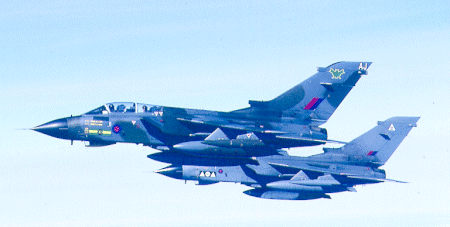Stewart Penney/RAF MARHAM & RAF WITTERING

During the past decade, fighters have flown into harm's way over Iraq and Yugoslavia almost daily to ram home the international community's determination that oppression will not be tolerated. As the end of the century that witnessed the birth of air power draws to a close, it is perhaps possible to answer a question that has been around since the first armed aircraft appeared. Can air power succeed by itself? Lessons from operational flying are being applied to new weapons, capabilities and aircraft upgrades.
The Royal Air Force Officer Commanding Marham-based II(AC) Sqn (OCII) says operations over Iraq and Yugoslavia have "proved the utility of air power and that it is the weapon of choice politically". A Panavia Tornado GR1/1A unit, II(AC) Sqn, was key to Operation Bolton, the RAF element of Operation Desert Fox.
But OCII cautions against using statistics, such as the number of tanks destroyed, to measure air power's success: "We didn't start the war to destroy tanks, but to stop oppression."
Officer Commanding 1 Sqn (OC1) agrees. "The fact is, [Yugoslav President Slobodan] Milosevic left the country, forced out by a superior force," he says. This was despite the known difficulties of targeting hidden forces. When there are civilians and non-antagonists in the area, it is more difficult." 1 Sqn and its British Aerospace Harrier GR7s were a major part of the RAF's contribution to Operation Allied Force.
Recent conflicts "show the need for the RAF to be capable across the full range of weapon capabilities - low, medium, high level", according to OCII. While today's actions tend to be at medium altitude, air forces must not become reliant on it as a tactic, he cautions, adding that low level skills must be retained.
Towards the end of Allied Force, 1 Sqn pilots requalified for low-level night missions. OC1 says that his squadron was the only unit to provide day and night low-level combat air support (CAS) for Kosovo force's (KFOR's) entry into Kosovo. "When KFOR went in, they might have needed low level CAS at night. It wasn't needed. If ground forces had been in from the start, we would have done low level missions."
A II(AC) Sqn flight commander says: "From the ground attack point of view, the specialist squadron is almost a dying breed." The aircrew need to be multiskilled, he adds.
"The level of expected corporate knowledge needed is immense. The knowledge of weapons and tactics is very high now," says the flight commander. OCII adds: "It struck me very forcibly while in Kuwait that we have first tour pilots with 18 months' squadron experience who do what they are meant to do. We are very much a combat-seasoned air force, which is a marked change [from the Cold War]."
To be multiskilled, training is vital and the right facilities must be in place. OCII says the RAF needs a rangeless air combat manoeuvring instrumentation capability to improve the debriefing process. A first tour II(AC) Sqn pilot says that training is crucial. "It takes three weeks to become TIALD [thermal imaging airborne laser designator] combat ready. That's not something you want to do in the operational environment." A training facility for the TIALD targeting pod has been built.
Station Commander Wittering says unaddressed areas of training are being studied following Allied Force, particularly training with TIALD and laser guided bombs (LGBs). "Some pilots had not done TIALD/LGB operations for real. You're never confident until you have," he says. This is being studied and will result in a "better trained and rounded operator", he adds.
Boeing F-15C Eagle pilot Lt Col Cesar Rodriguez, 493rd Fighter Squadron, is the highest scoring pilot in the US Air Force, having shot down a Mikoyan MiG-23 and a MAPO MiG-29 in Operation Desert Storm in 1991, and a MiG-29 during Allied Force. He is concerned that budget planners are "not willing to put money into training - all the money's being put into assets. Training requires a big chunk of integration." He adds that an air force "is as good as its training plan. If a unit is not allowed to participate in major exercises, fly against other air forces and only trains internally, its integration is more difficult."
Low level penetration
A II(AC) Sqn pilot says the Raytheon Raptor reconnaissance pod is a positive development as it can downlink imagery in real time. It also allows high-level stand-off missions that will reduce an enemy's reaction times. The Iraqis and the Serbs tend to move equipment after an overflight in an effort to prevent its destruction by a follow-up strike force.
II(AC) Sqn is receiving upgraded Tornado GR4/4As, which have a covert low level penetration capability. Before, such missions relied on the aircraft's terrain-following radar, an emitter that can be tracked by an enemy.
Importantly, says OCII, the Tornado GR4 has an improved databus, simplifying the integration of new systems and weapons - including the Matra BAe Dynamics Storm Shadow stand-off air-to-surface weapon and the Brimstone anti-tank missile. Today's Tornados have a mix of capabilities. Some can be fitted with the TIALD, others with the BAe Sea Eagle anti-ship missile. A II(AC) flight commander says it will be good to have a generic fleet "and bolt on the weapon of choice, rather than finding the right airframes".
OC1 would like a datalink such as the joint tactical information distribution system to aid situational awareness, while a helmet-mounted sight integrated with the TIALD would "bring the workload down big time".
Source: Flight International























